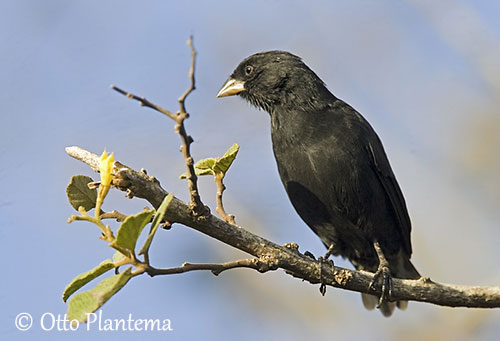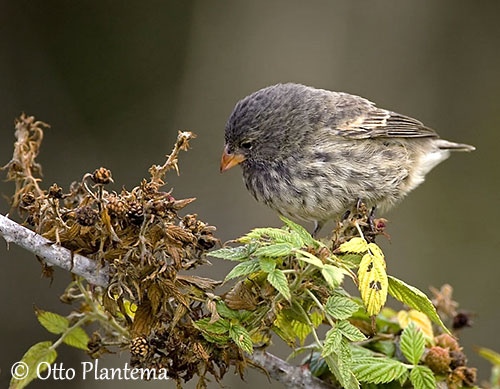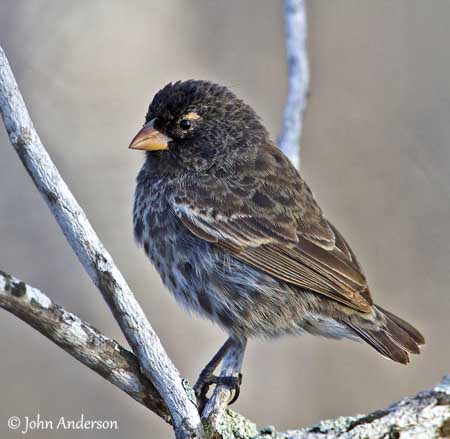
Fr: Géospize fuligineux
All : Kleingrundfink
Esp: Pinzón de Darwin Fuliginoso
Ital: Fringuello terricolo piccolo
Nd: Kleine Grondvink
Sd: Mindre Darwinfink
Photographers:
John Anderson
John Anderson Photo Galleries
Otto Plantema
Trips around the world
Text by Nicole Bouglouan
Sources:
HANDBOOK OF THE BIRDS OF THE WORLD Vol 16 by Josep del Hoyo- Andrew Elliot-David Christie – Lynx Edicions – ISBN: 9788496553781
BirdLife International (BirdLife International)
Wikipedia, the free encyclopaedia
Small Ground-Finch
Geospiza fuliginosa
Passeriforme Order – Thraupidae Family
Darwin’s Finches - Generalities
INTRODUCTION:
The Small Ground-Finch is endemic to the Galapagos Islands. Like the other Darwin’s Finches, the male is black and the female is paler with streaked plumage. This one is the smallest species of the genus Geospiza.
DESCRIPTION OF THE BIRD:
Biometrics:
Length: 10-11 cm
Weight: 12-17 g
The adult male is almost entirely black, with brown wash on wings and tail. The vent is white. The undertail-coverts are tipped black.
The bill of this species has relatively straight culmen and is longer than it is deep, involving more triangular shape than the mostly round-topped bill of the Medium Ground-Finch. The bill is black during the breeding season, turning brown with orange base and yellow tip during the transition, and becoming orange-yellow outside the breeding season. The eyes are dark brown. Legs and feet are blackish.

The female is dark grey-brown or dark olive-brown, with greyish-edged feathers on head and upperparts, involving scaled pattern. Wings and tail are dark brown with conspicuous pale buff edges.
The underparts are whitish to pale buff, streaked dark grey-brown, but central belly and vent are almost uniformly whitish.
The head can be mostly streaked with buff loral area and eyering. Chin and throat are pale buff but variable, sometimes with small dark spots and dark streaks. The bill is similar to that of male according to the period.
Some young females are paler and look almost unstreaked, with only some diffuse streaking on crown and a pale streak above the eye.
The immature male is usually between the streaked female and the black male.
RANGE:
The Small Ground-Finch is found in Galapagos and this species occurs almost on all islands.
HABITAT:
The Small Ground-Finch occurs at all elevations, up to 1700 metres, from arid lowland areas with cacti, deciduous shrubs and small trees, to moist highland forest dominated by trees of genus Scalesia, endemic to Galapagos.
This species occurs in large numbers in highlands during the non-breeding season.
CALLS AND SONGS: SOUNDS BY XENO-CANTO
The Small Ground-Finch male usually utters only one song type, a repetition of two nasal notes “clzeeuu clzeeuu” with a pause of several seconds between the paired notes.
BEHAVIOUR IN THE WILD:
The Small Ground-Finch forages mainly on the ground and consumes small seeds, buds and insects, but seeds are the main food. It also feeds on fruits from Opuntia cactus.
In the highland areas, it often forages in the low vegetation. Small food items are usually taken, related to shape and size of its compact bill.

The breeding season occurs during heavy rains, when food resources are abundant. Competition for food can be intense between the different Darwin’s Finches species.
Pairs are monogamous, and maintain a small territory where the nest-site will be included.
The Small Ground-Finch is largely resident in its range. Some altitudinal movements are reported during the non-breeding season. They also may disperse between islands.
This species usually performs short-distance flights. It is mainly terrestrial, hopping and moving easily among the vegetation. Its short, rounded wings do not allow this species to travel long distances.
REPRODUCTION OF THIS SPECIES:
The breeding season takes place during the rains.
The nest is built by the male within the small territory. That is a small dome-shaped structure, a sphere with side entrance towards the top.
The female lays 3-4 whitish eggs with darker spots. The incubation lasts about 12 days. The chicks are fed by both parents with insects. They fledge about two weeks after hatching.
PROTECTION / THREATS / STATUS:
The Small Ground-Finch is common or abundant. It is widespread in its range in all habitat types. This species is not currently threatened.
